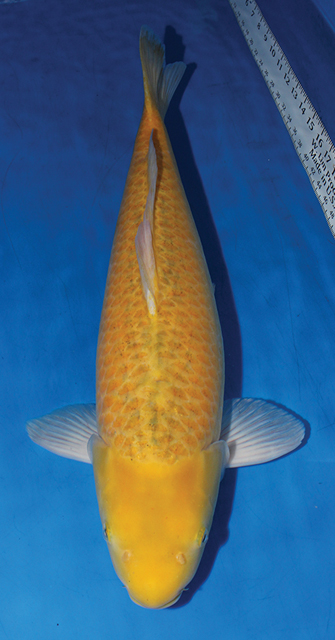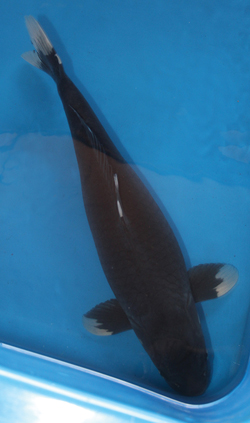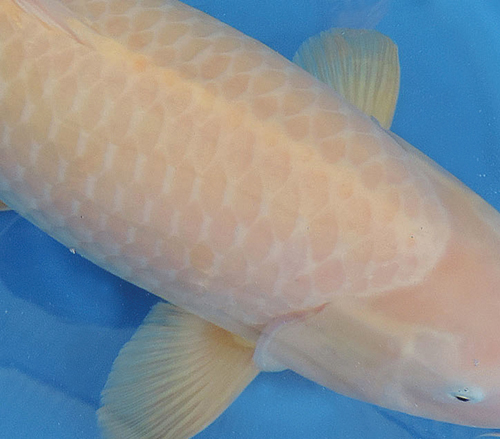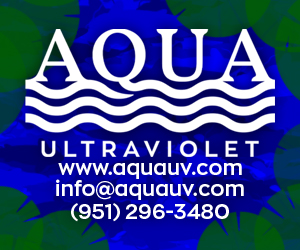
Muji means plain ground, or simply “plain” in Japanese. In koi terms, it refers to koi with a single color, such as Chagoi, Soragoi, Benigoi, Karashi, Karasu, Midorigoi and Kigoi. Honestly, I am surprised to see that there are so many included in the Muji variety. They are usually categorized in the Kawarimono class at koi shows.
Chagoi (brown), Soragoi (blue-gray) and Karashi (yellow) are probably the most popular varieties and are easily available among the monochrome Muji koi variety. They are friendly, eat very well and grow quickly. Karashi is especially in high demand. At koi shows in Japan, Chagoi have always been the most awarded in the jumbo category, but lately, Karashi have also been winners.
Kigoi or Karashi?
Many people wonder about the difference between Kigoi and Karashi because they both have yellow bodies. Although they are slightly different in coloration, it is still very difficult to identify which is which unless you ask the breeders. When I ask around — in Niigata — I find only a few people able to distinguish them.
Karashi was originally developed by crossing Kigoi and Chagoi. This is why Karashi has many features of Chagoi. Karashi will eat well and grow very quickly, unlike Kigoi. Karashi may have red-brown edges on their tail fins. Sometimes it may look like a sign of stress, but in the case of Karashi, this color is most likely derived from Chagoi. Quality Karashi should have yellow all the way down the pectoral fins, while Kigoi may have white fins.
The Artist’s Koi
Karasu is also a very interesting Muji. It is just a black koi. Some may wonder why breeders needed to develop black koi, considering that the original koi were black food carp. Although the carp were already black, I believe they were not black enough for the breeders as artists. They wanted to see a pure, lustrous, thick black that was not influenced by the environment on the koi’s body. This is a very good example of some breeders also serving as perfectionists or artists. In Karasu, we see different versions, with white on the edge of the fins of Hajiro, on the heads, pectoral fins and tail fins of Yotsushiro, and on Matsukawabake.
Because Muji have no pattern, we will consider the following when studying these koi: body conformation, cleanliness and Fukurin (or netting pattern).Body Conformation: Going back to the basics of koi appreciation, three important factors are body, quality and pattern in the order. Because these koi do not have a pattern, the importance of body conformation is great. Their bodies are like the canvas of painting. These canvases set the standard for their quality and beauty.

Karasu with white edges on
pectoral and tail fins.
Cleanliness: Remember that this is a plain-colored koi. Even a dot of red could ruin its beauty. If it were a multicolored koi, any wrongly placed colors on the body could be disguised. But in the case of Muji, one spot, regardless of how tiny, could ruin it. In other words, Muji are required to be more perfect than other varieties.
Fukurin: Fukurin refer to the netting patterns formed by the gaps in scales. When koi are small, all the scales are tightly laid out; there are no gaps. As koi bodies grow larger, especially in fast-growing koi like Chagoi, Soragoi and Karashi, their scale growth starts to slow, showing these gaps, or Fukurin. Because Muji do not have a pattern, Fukurin are one of the few highlights. How well they appear greatly impacts the value of the Muji.
On the other hand, not all Muji will have Fukurin. Fukurin definitely represent additional value, but a lack of Fukurin does not necessarily lower the quality of the koi. Still, one would prefer to see a nice netting pattern on the body.
A Koi for All
In my opinion, everyone should have at least one Muji in his or her pond. They are not afraid of people and actually help other koi calm down. They can be good leaders in the pond. So, their friendly personalities are a good selling point.
In addition, when showing mid- and large-sized Muji, remember to emphasize the beauty of the body and skin. When showing small ones, show them side by side with the larger ones and emphasize the importance of the bloodline. Breeding these simple koi may look easy, but I think no other variety is as difficult to breed as Muji. Because they are so simple, any small flaw, like a tiny spot or minor disorder of the scales, will impact their beauty. These small flaws may not be seen when they are small, but as the koi grow, they will come out. This is another reason why I stress so much the importance of bloodline. Bloodline is the only thing that assures the future quality of koi.

appearance creates beauty and value.
Some famous breeders of Chagoi and Soragoi include Marudo Koi Farm, Maruhiro Koi Farm and Marusaka Koi Farm. As for Karashi, Marudo Koi Farm and Konishi Koi Farm are famous. Otsuka Koi Farm always has high-quality Kigoi. Marusaka Koi Farm is a good place to go to find a nice Midorigoi. Karasu, however, is very hard to find. You simply have to visit many breeders and hope you happen upon one.


